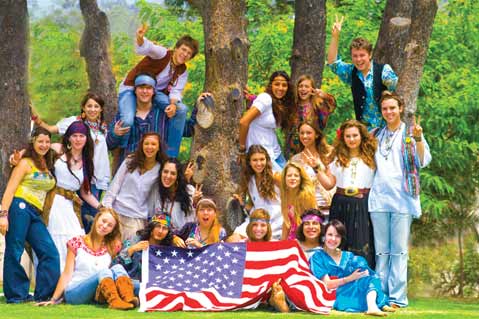HAIR
At the Santa Barbara High School Theatre, Thursday, July 31.

The split that divided the generation of the 1960s is one that transcends all eras-the massive contradiction of love against hate. While the youth of the ’60s doused its spirits with love, many of their elders urged them to fight and kill in Vietnam. HAIR shows an era of revolution where values were redefined as children were sent by their parents to protect them (as in the song “I Got Life”), love for the community overwhelmed love for another individual (as in “Easy to Be Hard”), and duty challenged integrity. Now, with the decade of HAIR 40 years past, Santa Barbara High School has brought this beautiful representation of love, war, and hope back to life. Directed by Otto Layman and choreographed by Christina McCarthy, HAIR moves its audience to reconsider the ’60s most threatening question: “What do you want to do with your life?”
HAIR opens with the hit song “Aquarius,” which is sung incredibly well Carlin Traxler, who plays Sheila, the protestor from NYU. Next, Berger (Cole Patterson) and the Tribe appear and set the scene: a commune of love. Claude (Critter Canfield) enters this world as an impending anomaly. This is because he has just been drafted for the war, although his internal struggle is exposed more to the audience than to his friends Berger and Sheila. In a tangle of bodies and voices, the fight to “make love not war” unfolds in sonic booms and projected images of burning draft cards, balanced by numerous images of American flags. Although they believe that the draft is “white people sending black people to fight yellow people to protect the country they stole from the red people,” no matter how many draft cards they burn, reality inevitably hits our hairy tribe.
From the strong beginning of “Aquarius” to Claude’s tragic death, the cast moves with complete control, reminding an audience of elders that time has moved on from their free-flowing, hippie childhood days to those of today’s more grounded and somewhat more mature youth. Nonetheless, as Jana McIntyre exemplifies through her excellent rendition of “Good Morning Starshine,” it wasn’t just “the movement” but also the voices of the era that gave hope to the youth of the ’60s. Canfield is great as Claude, and the eerily happy final number, “Let the Sun Shine In,” leaves the audience in awe of these young adults’ ability to render the passions of the past so poignantly present.



